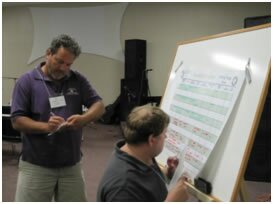The efficient and proper management of unaffiliated, often spontaneous volunteers in times of emergency is crucial to being able to respond to the disaster. Here are some tips for managing the power and talent of those who want to support disaster recovery efforts.
Understand that volunteers are a community. Volunteering is a valuable part of h healthy community. Volunteers come from all segments of society and often provide essential services. Everyone has the potential to contribute their strength and resources in the aftermath of a disaster.
Volunteers can be involved in more than just immediate recovery efforts. There are valuable and appropriate roles for unaffiliated spontaneous volunteers in mitigation, preparedness, response and recovery – as well as in other aras of community need. The response phase provieds an opportunity to direct volunteers toward longer-term affiliation and community involvement.
Management systems. Volunteers are a valuable resource when they are trained, assigned, and supervised within established emergency management systems. Similar to donations management, an essential element of every emergency management plan is the clear designation of responsibility for the on-site coordination of unaffiliated volunteers.
Shared responsibility. The mobilization, management, and support of volunteers is primarily a responsibility of local government and nonprofit agencies with support from the state level. Specialized planning, information sharing, and a management structure are necessary to coordinate efforts and maximize the benefits of volunteer involvement.
Volunteer expectations. Volunteers are successful participants in emergency management systems when they are flexible, self-sufficient, aware of risks, and willing to be coordinated by local emergency management experts.
The impact on volunteers. The priority of volunteer activity is assistance to others. When this spontaneous activity is well managed, it also positively affects the volunteers themselves and thus contributes to the healing process of both individuals and the larger community.
Build on existing capacity. All communities include individuals and organizations that know how to mobilize and involve volunteers effectively. Emergency management experts and VOAD partners are encouraged to identify and utilize all existing capacity for integrating unaffiliated volunteers.
Managing information. Clear, consistent, and timely communication is essential to successful management of unaffiliated volunteers. A variety of opportunities and messages should be utilized in order to educate the public, minimize confusion, and clarify expectations.
Say thank you. Don’t forget to take the time to thank the volunteers who are showing up to help with disaster recovery. Many of them will likely be the same people who were affected by the disaster. Taking the time to say thank you and show that you care about them can help them to recover from their ordeal.


 Abby Simons an AmeriCorps-St. Louis member who serves as liaison with Missouri Southern State University, says the need for volunteers still exists.
Abby Simons an AmeriCorps-St. Louis member who serves as liaison with Missouri Southern State University, says the need for volunteers still exists.
 Since the earthquake, we have been working with our
Since the earthquake, we have been working with our 
 Blake Canterbury started
Blake Canterbury started 

